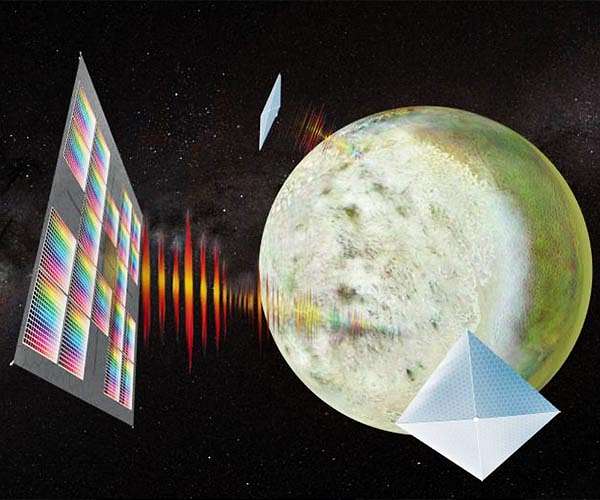
Quantum Dot instrument enables spacecraft-as-sensor concept (Image Credit: Space Daily)
In NASA’s hunt for water and resources beyond Earth, a new technology could coat the “skin” of a satellite, turning its entire surface into a sensor that tallies the chemicals present on distant planets.
Solving the mysteries of our home planet, solar system, and beyond is a key priority for NASA, and the new sensor could be a powerful tool in the investigation. Mahmooda Sultana, an instrument scientist at NASA’s Goddard Space Flight Center in Greenbelt, Maryland, developed the Quantum Dot Spectrometer to help.
Quantum dots are a type of semiconducting nanocrystal that absorbs and re-emits different wavelengths of light depending on their size, shape and chemical composition. Sultana gets her dots, which vary from 2 to 10 nanometers or less than 50 atoms thick, from the lab of chemistry professor Moungi Bawendi, at the Cambridge-based Massachusetts Institute of Technology.
She then uses them to break down light from a planet or other target into portions of the spectrum, creating a sort of fingerprint which reveals what elements or compounds that light has touched.
“Basically, we are converting the entire optical problem into a math problem,” Sultana said. “The dots can be identified in the lab to register light of a particular wavelength – a fraction of the chemical fingerprint. Detectors on the other side of the dots collect the fractions, then the data is handed over to computers on the ground to reassemble the complete fingerprint.”
“The math is complex,” she added, “but using machine learning, we are able to get amazing accuracy, even on more complex spectral curves.”
A typical spectrometer can be a relatively bulky piece of equipment, taking up precious real estate aboard a satellite. What sets Sultana’s Quantum Dot Spectrometer apart is a literally small miracle of modern chemistry.
Enabling new applications on small satellites as well as solar sails, Sultana’s instrument has potential for studying Earth’s surface composition, ocean color, vegetation, and atmospheric chemistry, as well as providing insight into auroral interactions. As an engineer interested in planetary science, Sultana said her quantum dot spectrometer could identify water and other chemicals in lunar soil and characterize surface and atmospheric elements of other planets.
ScienceCraft – a New Vision for Exploration
The versatility of the quantum dot technology could enable a low-cost mission to an outer solar system planet.
Her concept – ScienceCraft for Outer Planet Exploration, or SCOPE – capitalizes on the sensor’s versatility and low mass. A solar sail, printed with separate layers for readout electronics, detector array, quantum dot spectrometer, and microlens array, would serve as a spacecraft, propulsion system, and science instrument in one.
Sultana calls this vision for future exploration vessels ScienceCraft.
She is working to develop this mission concept through a Phase I NASA Innovative Advanced Concepts (NIAC) program award granted this April. Her team has already automated the dot printing process. The sail concept is being developed by co-investigator Artur Davoyan, a professor at UCLA.
“This is a game-changing concept,” she said. “We are essentially addressing three of the key barriers to outer solar system exploration: the high cost, long travel time, and a narrow window to launch a mission that can rendezvous with these distant planets.”
Driven by the gentle pressure of sunlight across a large area, the sail would pick up speed by orbiting close to the Sun, propelling it into the outer solar system.
Once there, Sultana’s vision could accomplish critical science goals, Goddard planetary scientist Conor Nixon said.
“There is currently a gap for exploring the Neptune-Triton system,” he said. “Can we do some Neptune science on a fast-flyby, lower-cost mission? It’s the sort of planetary system that SCOPE could find a niche in exploring.”
In 1989, Voyager 2’s close-up images of Triton first revealed its icy surface, marked by plumes that hinted at an active geology and a hidden ocean beneath the ice. Investigating how Triton has changed over time would help scientists better understand how solar system bodies evolve and function.
“As people around the world develop the capability to print electronics or produce different materials and structures, more instruments like the Quantum Dot Spectrometer can be printed directly with the solar sail to create additional ScienceCraft opportunities,” Sultana said.
Related Links
Science Instruments at NASA
Space Technology News – Applications and Research
|
|
Tweet |
|
|
|
We need your help. The SpaceDaily news network continues to grow but revenues have never been harder to maintain. With the rise of Ad Blockers, and Facebook – our traditional revenue sources via quality network advertising continues to decline. And unlike so many other news sites, we don’t have a paywall – with those annoying usernames and passwords. Our news coverage takes time and effort to publish 365 days a year. If you find our news sites informative and useful then please consider becoming a regular supporter or for now make a one off contribution. |
||
|
SpaceDaily Monthly Supporter $5+ Billed Monthly
|
SpaceDaily Contributor $5 Billed Once
credit card or paypal |
|
Leanspace and Valispace team up to demonstrate the power of Digital Continuity in space mission management
Logan UT (SPX) Aug 23, 2022
Numerous software tools are typically required throughout a space mission; from the mission conceptualization and satellite design, to testing the hardware, to running operations. Still today, this technology stack consists of independent systems that don’t talk to each other, requiring manual movement of data, limiting automation and forcing engineering teams to work with different data sets.
In the current context of commercialization of the space industry, where every organization strives to be … read more





